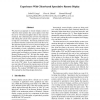Free Online Productivity Tools
i2Speak
i2Symbol
i2OCR
iTex2Img
iWeb2Print
iWeb2Shot
i2Type
iPdf2Split
iPdf2Merge
i2Bopomofo
i2Arabic
i2Style
i2Image
i2PDF
iLatex2Rtf
Sci2ools
USENIX
2008
2008
Experiences with Client-based Speculative Remote Display
We propose an approach to remote display systems in which the client predicts the screen update events that the server will send and applies them to the screen immediately, thus eliminating the network round-trip time and making the system more responsive in a wide-area or high loss environment. Incorrectly predicted events are undone when the actual events arrive from the server. The approach requires no server or protocol changes, and thus can work with existing systems. Since it is core to the feasibility of such a speculative remote display system, we study the predictability of the events that occur under typical workloads in two extant systems, Windows Remote Desktop and VNC. We find that simple, statelimited Markov models are often able to correctly predict the next event. Based on these results, we design, implement, and evaluate a speculative remote display extension to the VNC client. In our implementation, the end user can trade off between the responsiveness of the display...
Operating System | Remote Display | Remote Display System | Speculative Remote Display | USENIX 2008 |
| Added | 02 Oct 2010 |
| Updated | 02 Oct 2010 |
| Type | Conference |
| Year | 2008 |
| Where | USENIX |
| Authors | John R. Lange, Peter A. Dinda, Samuel Rossoff |
Comments (0)

